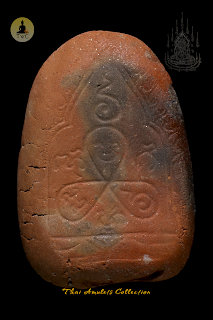Phra Somdej Prok Pho Lang Yant Nur Din BE2470-2476 Luang Pu Thong (Lp Thong) Wat Rachayota
History of Phra Somdej Prok Pho Lang Yant
Type: Phra Somdej Prok Pho (Bodhi Leaf Canopy)
Material: Nur Din (Sacred Clay)
Back: Embossed with sacred Yant (Yantra)
Period of Creation: B.E. 2470–2476 (1927–1933 CE)
Creator: Luang Pu Thong (Lp Thong)
Temple: Wat Rachayota, Bangkok
Certification: Accompanied by a Thaprachan Certificate (authenticity standard in Thailand)
1. Historical Context
The amulet was created during a time of religious revival in Bangkok during the late reign of King Rama VI to early Rama VII, when sacred talismans were sought for spiritual protection, prosperity, and health.
Luang Pu Thong, a highly revered monk of the Bangkok Yai district, was known for his deep meditative attainments and mastery of sacred Khmer-Yantra inscriptions, which he learned from senior Khmer and Thai meditation masters.
This amulet was produced at Wat Rachayota, one of the lesser-known temples in Thonburi with deep spiritual roots and a lineage tracing back to early Ayutthaya-era monastic practices.
2. Purpose of Creation
The Phra Somdej Prok Pho Lang Yant was created for:
-
Protection of devotees from spiritual and physical dangers
-
Spreading the Dhamma through blessed sacred objects
-
Supporting temple restoration and monk education in the Bangkok Yai area
The name Prok Pho refers to the Buddha seated under the Bodhi tree, symbolizing enlightenment, peace, and divine shelter. The Yant (mystical diagram) inscribed on the back is intended to further empower the amulet with metta (loving-kindness) and katha (sacred incantation) energy.
3. Material and Composition
The amulet was made using Nur Din, a sacred clay mixture, incorporating:
-
Soil from temple grounds mixed with incense ash, flower pollen, and powdered remains of ancient votive tablets
-
Holy water from Pali chanting ceremonies
-
Clay from sacred sites, including the banks of the Chao Phraya and Bangkok’s old temples
The mixture was carefully kneaded and pressed into custom-carved molds by Luang Pu Thong himself or under his close supervision.
4. Sacred Features
-
Front Design: Buddha image seated in meditation under the Bodhi leaf (Prok Pho), atop a multi-tiered throne
-
Back Design: Prominent Yant (sacred geometry inscription) with Khmer script and iconography to enhance spiritual potency
-
Texture: Clay surface with natural patina, often showing age-related cracking (kraap), indicating authenticity and time
Each piece was hand-finished and blessed individually, creating subtle variations and individuality among amulets from this batch.
5. Consecration Ceremony
The amulets were blessed over several years, from B.E. 2470–2476, during major Buddhist ceremonies involving:
-
Full moon and Buddhist holy day prayers
-
Chanting of 108 sacred Pali katha by senior monks of the Thonburi and Ayutthaya traditions
-
Intensive Vipassana meditation by Luang Pu Thong and accompanying monks during the rainy retreat (Phansa)
These ceremonies imbued the amulets with long-lasting spiritual energy, making them cherished by laypeople and collectors alike.
6. Rarity and Certification
Due to their limited production, natural clay fragility, and high demand during the 20th century, few pieces remain today. Authentic examples are considered rare and valuable.
-
This amulet is certified by Thaprachan, a leading institution for authenticating Thai amulets, confirming its legitimacy and provenance.
-
Frequently seen in collector showcases and national-level amulet exhibitions
7. Known Powers and Beliefs
-
Protection from harm and black magic
-
Attraction of goodwill (Metta Mahaniyom)
-
Enhancement of meditation and mindfulness
-
Support in spiritual growth and life stability
Collectors and practitioners believe it rivals the sacred energy of earlier-generation Phra Somdej from Wat Rakang or Bang Khun Phrom in terms of personal spiritual benefit.

%20Wat%20Rachayota%20with%20Thaprachan%20Certificate%2001.png)




.png)



.png)
%20Wat%20Rakang.png)

%20Wat%20Thepsirin%20Issued%20to%20Wat%20Sin%20Khan.png)
